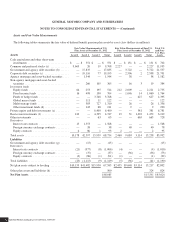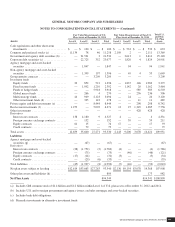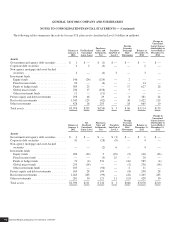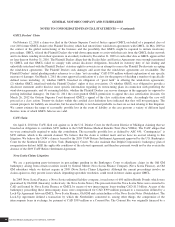General Motors 2012 Annual Report Download - page 141
Download and view the complete annual report
Please find page 141 of the 2012 General Motors annual report below. You can navigate through the pages in the report by either clicking on the pages listed below, or by using the keyword search tool below to find specific information within the annual report.
GENERAL MOTORS COMPANY AND SUBSIDIARIES
NOTES TO CONSOLIDATED FINANCIAL STATEMENTS — (Continued)
Significant Concentrations of Risk
The pension plans’ assets include certain private investment funds, private equity and debt securities, real estate investments and
derivative instruments. Investment managers may be unable to quickly sell or redeem some or all of these investments at an amount
close or equal to fair value in order to meet a plan’s liquidity requirements or to respond to specific events such as deterioration in the
creditworthiness of any particular issuer or counterparty.
Illiquid investments held by the plans are generally long-term investments that complement the long-term nature of pension
obligations and are not used to fund benefit payments when currently due. Plan management monitors liquidity risk on an ongoing
basis and has procedures in place that are designed to maintain flexibility in addressing plan-specific, broader industry and market
liquidity events.
The pension plans may invest in financial instruments denominated in foreign currencies and may be exposed to risks that the
foreign currency exchange rates might change in a manner that has an adverse effect on the value of the foreign currency denominated
assets or liabilities. Forward currency contracts may be used to manage and mitigate foreign currency risk.
The pension plans may invest in fixed income securities for which any change in the relevant interest rates for particular securities
might result in an investment manager being unable to secure similar returns upon the maturity or the sale of securities. In addition,
changes to prevailing interest rates or changes in expectations of future interest rates might result in an increase or decrease in the fair
value of the securities held. Interest rate swaps and other financial derivative instruments may be used to manage interest rate risk.
Counterparty credit risk is the risk that a counterparty to a financial instrument will default on its commitment. Counterparty risk is
primarily related to over-the-counter derivative instruments used to manage risk exposures related to interest rates on long-term debt
securities and foreign currency exchange rate fluctuations. The risk of default can be influenced by various factors including macro-
economic conditions, market liquidity, fiscal and monetary policies and counterparty-specific characteristics and activities. Certain
agreements with counterparties employ set-off, collateral support arrangements and other risk mitigating procedures designed to
reduce the net exposure to credit risk in the event of counterparty default. Credit policies and processes are in place to manage
concentrations of counterparty risk by seeking to undertake transactions with large well-capitalized counterparties and by monitoring
the creditworthiness of these counterparties. The majority of derivatives held by the plans at December 31, 2012 were fully
collateralized and therefore, the related counterparty credit risk was significantly reduced.
Pension Funding Requirements
We are subject to a variety of U.S. federal rules and regulations, including the Employee Retirement Income Security Act of 1974,
as amended and the Pension Protection Act of 2006, which govern the manner in which we fund and administer our pensions for our
retired employees and their spouses. In 2012 the U.S. government enacted the Moving Ahead for Progress in the 21st Century Act
which allows plan sponsors funding relief for pension plans through the application of higher funding interest rates. As a result, under
current economic conditions, we expect no mandatory contributions to our U.S. qualified pension plans for at least five years. The
new law does not impact our reported funded status. We have no funding requirements for our U.S. qualified plans in 2013.
We also maintain pension plans for employees in a number of countries outside the U.S. which are subject to local laws and
regulations.
General Motors Company 2012 ANNUAL REPORT138
























